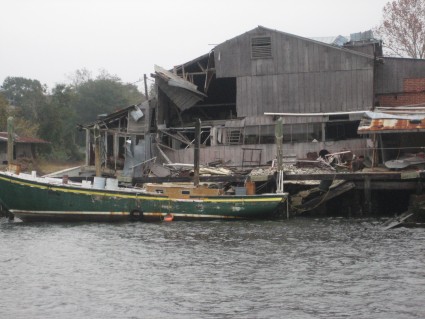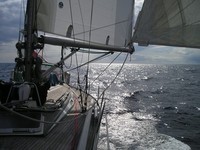
Semper Vivens
04 October 2010 | Berlin, DE
29 September 2010 | Düsseldorf-Köln-Düsseldorf
28 September 2010 | Muiden – Terborg - Düsseldorf
27 September 2010 | Amsterdam, NL
27 September 2010 | Callantsoog, NL (6m below sea level)
25 September 2010 | Callantsoog-Hoorn-Breezanddijk-Den Helder-Callantsoog NL
23 September 2010 | Arras, France
22 September 2010 | Dieppe-Picquigny-Albert-Vimy, FR
21 September 2010 | Pourville(Dieppe), FR
19 September 2010 | Le Mont St-Michel, Saint-Malo, Tréhorenteuc
18 September 2010 | Courseulles-sur-Mer, FR
17 September 2010 | St-Agnan-le-Malherbe and Bayeux
16 September 2010 | St-Agnan-le-Malherbe
15 September 2010 | Heuqueville, FR
07 April 2010 | HFX
07 April 2010 | HFX
23 December 2009
16 September 2009 | HFX
06 September 2009 | hfx
01 September 2009 | HFX
Brunswick
29 November 2007 | Brunswick and Jekyll I., GA
Steve/overcast, 20C

Today we toured the Hofwyl-Broadfield Plantation, a former rice plantation on the Altamaha River outside Brunswick. The plantation was originally cypress swampland when acquired by its owners in 1806, so hundreds of African slaves were brought in to clear and level the marshes, and build dikes and drainage ditches to allow water to flood the rice fields during the growing season. Although the marshes are freshwater, brackish water can invade during astronomically high tides and hurricanes. Salt water was very destructive to the rice crop; once contaminated, it could take up to eight years before planting could begin again. The plantation prospered until the Civil War and its resultant physical and financial destruction. The end of slavery resulted in cheap labour being no longer available, and by 1880 the plantation was deep in debt owing taxes. The plantation stopped producing rice in 1915, and a dairy was established which became profitable enough to get the plantation out of debt by 1942. In the early 1970s, the last of the owners died with no heirs, and the plantation was left to the Nature Conservancy, which turned it over to the State of Georgia, and today it is a State Historic Site. The main house and several outbuildings are preserved, and the main house featured many original furnishings dating from the late 1700s. Outside is a live oak that is estimated to be anywhere between 400-800 years old...if only it could talk! It took eight of us to link arms around its trunk!
What struck us most about the plantation however, was not so much the appearance of the place, but the explanation of slavery and slave conditions offered by the park interpreter, who possessed a very detailed knowledge of the plantation and its owners. Still, it seemed as though she was trying to diminish the impact of slavery, pointing out that slaves were a small proportion of the population, that the French and Dutch used more slaves than America did, that slavery was quite common in Africa amongst the blacks themselves, that free blacks sometimes owned slaves, and that they were often left to run the plantation themselves in the months when malaria drove the white population inland, but the malaria-immune blacks from Africa were able to continue working. The interpretive displays back at the gatehouse/museum told a different story, relating that working conditions and discipline at rice plantations were usually harsher than at cotton plantations, and that slaves made up nearly seventy percent of the local population. Even though the slave trade was banned in Georgia in 1808, slave ships continued to bring slaves into the region until the late 1850s.
Pondering the legacy of the plantation and others like it, we returned to Brunswick. Like Savannah, Brunswick was laid out by General Oglethorpe in the late 1700s. Brunswick has an historic section, but we evidently missed it. Our short trips around town on errands and to visit the plantation took us through a run-down, dirty town that has seen better days. During World War II, Brunswick was a ship-building centre, known for turning out the famous Liberty Ships at a tremendous pace; one was built in 38 days! However, the waterfront is now mostly dilapidated and deteriorating, and I decided to go with the photo above as representative of my impressions, which contrasted severely with the rich veneer of a good portion of the waterfront we have seen so far. Jekyll Island is just a few miles away, and is host to the cottages of the Rockerfellers, Vanderbilts, Pulitzers and other millionaires, and it leaves one baffled at times how two places so close together could evolve so differently.
What struck us most about the plantation however, was not so much the appearance of the place, but the explanation of slavery and slave conditions offered by the park interpreter, who possessed a very detailed knowledge of the plantation and its owners. Still, it seemed as though she was trying to diminish the impact of slavery, pointing out that slaves were a small proportion of the population, that the French and Dutch used more slaves than America did, that slavery was quite common in Africa amongst the blacks themselves, that free blacks sometimes owned slaves, and that they were often left to run the plantation themselves in the months when malaria drove the white population inland, but the malaria-immune blacks from Africa were able to continue working. The interpretive displays back at the gatehouse/museum told a different story, relating that working conditions and discipline at rice plantations were usually harsher than at cotton plantations, and that slaves made up nearly seventy percent of the local population. Even though the slave trade was banned in Georgia in 1808, slave ships continued to bring slaves into the region until the late 1850s.
Pondering the legacy of the plantation and others like it, we returned to Brunswick. Like Savannah, Brunswick was laid out by General Oglethorpe in the late 1700s. Brunswick has an historic section, but we evidently missed it. Our short trips around town on errands and to visit the plantation took us through a run-down, dirty town that has seen better days. During World War II, Brunswick was a ship-building centre, known for turning out the famous Liberty Ships at a tremendous pace; one was built in 38 days! However, the waterfront is now mostly dilapidated and deteriorating, and I decided to go with the photo above as representative of my impressions, which contrasted severely with the rich veneer of a good portion of the waterfront we have seen so far. Jekyll Island is just a few miles away, and is host to the cottages of the Rockerfellers, Vanderbilts, Pulitzers and other millionaires, and it leaves one baffled at times how two places so close together could evolve so differently.
Comments
| Vessel Name: | Semper Vivens |
| Vessel Make/Model: | Avance 40 |
| Hailing Port: | Halifax, NS |
| Crew: | Judy, Steve, Stephanie and Marine |
| About: | Having completed a nine-month voyage in 'Semper Vivens' in 2007/08, the crew develops itchy feet again and decide to head over to Europe for a four-month "land cruise"! |
Gallery not available
About Us

Who: Judy, Steve, Stephanie and Marine
Port: Halifax, NS
